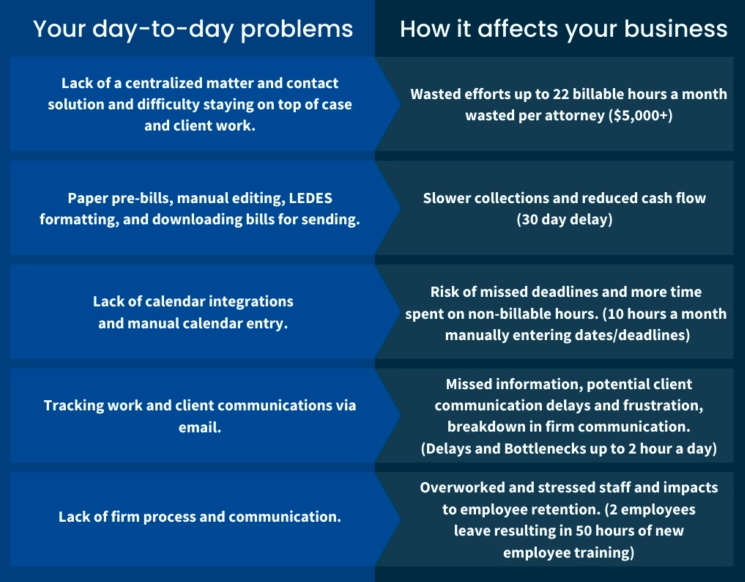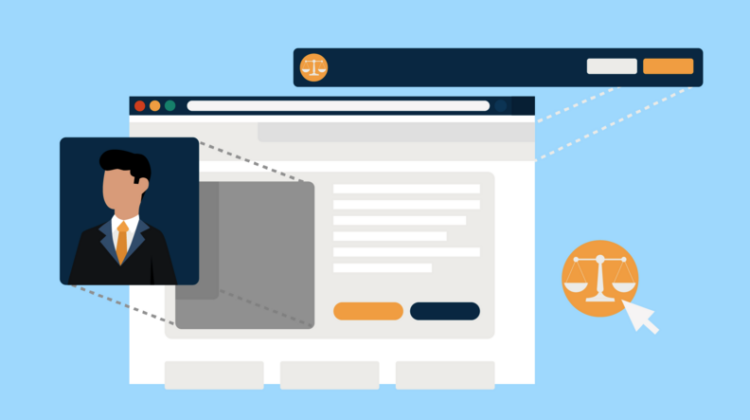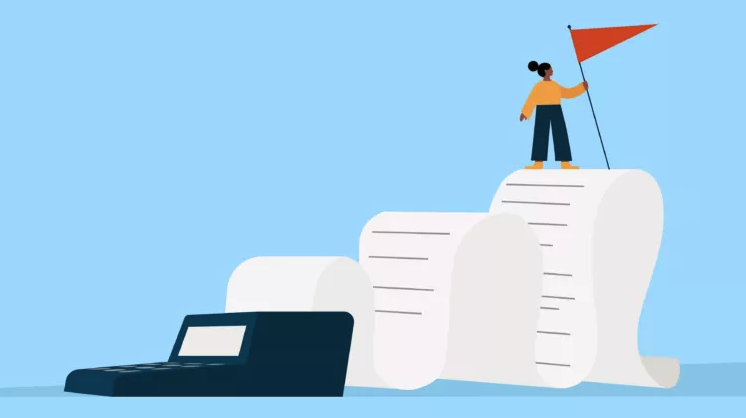In the world of law, tradition often reigns supreme. For centuries, the legal profession has stuck to time-honoured practices and methodologies, relying heavily on established norms. However, as the world evolves at an exceptional pace, sticking to the status quo can slow progress, suppress innovation, and in the long term, cause your firm to leave money on the table.
Today, more than ever, law firms face increased pressure to adapt and modernise to stay competitive due to the number of tools out there that are making it easier for lawyers to reach more clients. Client expectations are also increasing with technology making online payments, online meetings, etc., the norm. Yet, many law firms are hesitant to embrace change and disrupt established routines and workflows because of the time and effort involved.
In this post, we’ll dive into the transformative power of legal technology—and how not adopting the latest efficiencies offered by legal tech could mean your firm is leaving money on the table.
Time is money: The cost of indecision

Quantifying how much money or productivity you’re losing by doing what you’ve always done can be difficult. Even if you don’t see issues with your way of working, there’s likely an opportunity for you to be more efficient. Time is a lawyer’s most valuable resource, so investing dollars into software puts more time back in your day, opening up opportunities to spend that time on billable work or broader improvement projects for your firm.
It can seem hard to justify the time investment in adopting new processes and tools at first, as time is quantifiable but not as tangible as dollars in the bank. While you may not see time saved returned as dollars in your bank account immediately, you will notice an overall increase in your firm’s efficiency, expanding the opportunity to take on more billable work.
How to measure the impact of not making a change
When reviewing your current processes, identifying inefficiencies is often pretty straightforward.
You will inherently recognise non-billable tasks that consume excessive time or lack efficiency but you won’t always consider what this is truly costing you.
Talk with your firm’s staff and identify their pain points and the tasks that take them the longest. By pinpointing these areas and quantifying the time invested, along with considering the costs of running your business, you can begin to unveil opportunities for improvement.
Some questions to ask yourself and your firm staff:
- How long do common processes take? Is there a current process that is taking up more time than you would like? Do you know of a better way or tool to make this more process efficient?
- How reliable is our current solution? Does your current solution get the job done, but is it a slow process? Is your staff dealing with crashes, bugs, or an unreliable service?
- How comprehensive is your current product offering? Are you using different tools for billing, case management, payments, document automation, reporting, calendaring, etc.?
- How easy is your current process? Does everyone in the firm know how to use the tools? Is it easy to train new team members? Is it intuitive and user-friendly?
- Is support easily accessible? When looking to set up new online integrations, setting up new processes, or dealing with general questions, how easy are you able to contact support from your current tool? Do questions get answered in a timely manner?
- How often are mistakes made? With a lot of manual processes, human error, missed documents, missed signatures, or missed deadlines can affect any stage of a case.
Another way to look at measuring the cost of inefficiencies is to look at billable hours lost. As per the latest Legal Trends Report, lawyers are still spending the majority of their day on non-billable tasks. For example, if you’re sticking with your existing system for client intake and onboarding instead of using a solution that allows you to drastically reduce time spent on intake, appointment bookings, and creating engagement letters, you could be leaving money on the table.

Another example: Say that right now, billing takes you eight hours each month when using spreadsheets and Word documents. But if adopting a modern legal billing solution can reduce this time to 30-60 minutes, you’re freeing up approximately seven hours each month—that’s over 80 hours a year! Of course, that doesn’t automatically mean your firm will add 80 billable hours per year—you may not even bill by the hour—but this time spent on routine tasks could be invested in ideas and projects to grow your client base and grow your firm.
Ask yourself: how are operational tasks being completed at my firm today, and what else could I do with the extra time received from a more automated solution?
You may like these posts
For firm owners: The importance of technology for employee satisfaction
Employee satisfaction is a big piece of the puzzle when trying to shift away from the status quo. Some employees might be nervous about change, while others might be begging for it.
For example, when every team member must use a particular software, but it proves to be slow, and prone to crashes and errors, it inevitably creates frustration and can even lead to resentment in the workplace. On the flip side, some employees may cling to familiarity, finding comfort and security in software they’ve used for years, thus hesitating to embrace change.
When considering a change to the status quo at your firm, there are a couple of things to consider.
- Are you at risk of losing employees if you create change? Will your employees embrace change, and what will it cost to lose them? Take stock of your critical employees, and ensure you communicate proactively and put together an implementation plan that gets their buy-in and sets them up for success.
- Does only one person truly know and understand your current software system? Why is that, and what would happen if they leave? At the very least, ensure you have multiple people on your team who know and understand your firm’s current tools. When you switch to a new tool, find out what type of training is offered, and clearly document any specifics regarding how your firm uses the tool.
- Are your employees going to be set up for success? Switching software programs will involve training to ensure a healthy adoption–and for you to get the most bang for your buck. Read Jack Newton’s The Client-Centred Law Firm for tips not just on client-centered lawyering, but on change management as well.
The 2023 Legal Trends Report for Mid-Sized Law Firms, reported that 67% of lawyers in mid-sized firms using cloud-based LPM software reported that their relationships with colleagues were good or very good (compared to 35% of lawyers in mid-sized firms not using cloud-based LPM software).
Additionally, solo law firms using cloud-based LPM software are 24% more likely to report being happy with their professional life and 21% more likely to be satisfied with their own mental and emotional wellness, as reported in the 2023 Legal Trends Report for Solo Law Firms.
Here are a few ways legal software can make your firm more efficient and improve employee satisfaction:
Reduce billing inefficiencies
If you’re not using legal billing software, you might spend a lot of time manually tracking time, expenses, invoices and emailing clients with follow-ups and reminders for payment.
The 2023 Legal Trends Report for Mid-Market Firms found that 24% of those surveyed admitted that their firm takes too long to invoice or bill clients after completing the work. These inefficiencies during the billing process can lead to unpaid invoices, as often, the longer an invoice goes unpaid after the completion of a case, the higher the chances are that it will never be. Mid-sized law firms also reported getting paid more than twice as fast when using online payments from a legal billing software solution.
Furthermore, the 2023 Legal Trends Report reported firms using billing features saw modest increases in their realisation rates (the amount of hours billed) and collection rates (amount of billed hours collected on). In other words, not only does the average law firm bill more using these billing features as a powerful business lever—they often collect a greater proportion of their bills. Utilizing this technology will allow your employees and clients to experience a better billing workflow while you obtain more billable hours in your week
Reduce manual client onboarding
One of the more time-consuming tasks at any law firm is client onboarding: attracting new clients, gathering their information, setting up calls, and getting them logged into your system.
When using traditional methods, lawyers and firm staff may talk to the potential client over the phone or via email, often with a lot of back and forth. You must then manually add the client’s personal and case information into your current process and determine times to meet that work for both parties’ schedules (which can, again, lead to a lot of back and forth). This can be an extremely time-consuming and repetitive process that takes you away from billable work and other essential tasks.
With a more automated process using client intake software, you can free up hours of work with online intake forms that auto-fill info into key documents and forms and utilise a hands-free calendar scheduling tool. Leads will become clients more seamlessly, reducing the risk of losing clients and allowing your time to become more focused on the case at hand.
Reduce time locating templates and legal forms
As all lawyers, paralegals, and law firm administrators know, locating specific forms and legal templates can take up a lot of non-billable hours in a week. Sifting and sorting through documents is often just a part of the job, but it doesn’t have to be.
When working without a document management tool, legal professionals are stuck doing routine and rote work instead of work that adds more value to your firm. Being able to search through an online library of court forms and legal templates, save commonly used documents and forms, auto-fill information, and upload documents from other tools (OneDrive, Dropbox, Google Drive, etc.), right inside of a document management tool can reduce mistakes and frustration while giving you, and your staff, precious time back.
For firm staff: How to introduce change as an employee
If you don’t get to decide on what technology your firm uses, how do you go about convincing the partners that there is a better way? If you work for someone comfortable in their ways and their traditional processes, this may seem daunting, especially if the new process costs more than the current method.
The bottom line for any business owner and managing partner ultimately boils down to one thing: ROI (return on investment). They will be most interested in what this new technology will do for them and the firm’s overall success. It would be hard evidence to ignore if you can prove that they would be making a sound investment to save time, increase revenue and profits, improve employee satisfaction, and enhance overall business operations.
Stop paying to stick with the status quo
Legal technology has the power to revolutionise how law firms operate. By simplifying tasks with modern software solutions, you speed up processes like client intake, document management, and payments—creating new chances for your firm to improve its services and keep your clients and firm staff happy.
By making the switch to using legal software solutions, more of your time becomes money, as you’re able to take on more than before. The limits are truly endless, with the digital age introducing more innovative software solutions to improve the legal landscape all the time. And the best part of all, adopting technology in a firm allows lawyers to focus more on what truly matters—helping their clients.
Embarking on this change and ditching the tools and processes you’ve always used might appear intimidating, but the rewards will be noticeable from the jump. It’s high time for law firms to let go of old ways, welcome new ideas, and set sail toward a future full of success and prosperity. If you’re ready to dive into Clio, sign up for a demo today, and don’t forget to check out the attached resources to this article.
How to Successfully Implement Cloud-based Legal Software at Your Firm
We published this blog post in December 2024. Last updated: .
Categorized in: Business, Technology
Explore AI insights in our latest report
Our latest Legal Trends Report explores the shifting attitudes toward AI in the legal profession and the opportunities it brings for law firm billing, marketing, and more.
Read the report




